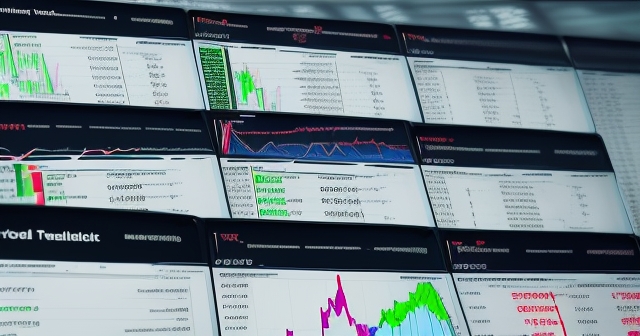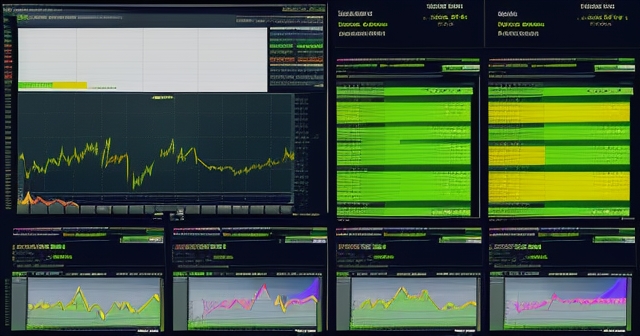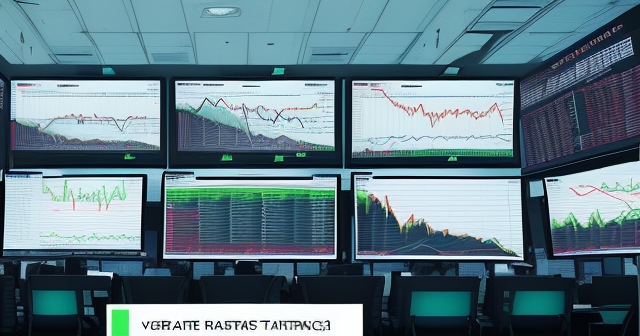Welcome, aspiring and seasoned traders! Today, we embark on a journey into a sophisticated corner of the financial markets: Volatility Targeting. You might have heard this term whispered among institutional traders or read about its impact during turbulent times. But what exactly is it, and how does it influence the world of investing and trading?
Think of investing not just as picking assets, but as managing risk. Volatility is a measure of price fluctuations, and effectively managing this fluctuation is paramount. Volatility targeting is a quantitative approach designed to keep your portfolio’s risk level consistent, regardless of how wild the market gets. It’s like setting cruise control for risk exposure.
We’ll explore the core principles behind this strategy, its practical applications, the types of market environments where it thrives or struggles, and its broader implications for the financial ecosystem. Our goal is to demystify this powerful technique, equipping you with the knowledge to understand its role and perhaps even consider how similar principles might apply to your own trading endeavors. Are you ready to dive deep?

At its heart, volatility targeting is a portfolio management technique that seeks to maintain a constant level of risk exposure by dynamically adjusting the size of positions in a portfolio. Imagine you have a specific risk budget – say, you’re comfortable with your portfolio fluctuating by a certain percentage over a given period. Volatility targeting aims to ensure that the actual fluctuation (the volatility) aligns with this target.
How does it achieve this? The fundamental mechanism is straightforward: when market volatility rises, the strategy reduces exposure (e.g., by selling assets or reducing leverage). When market volatility falls, it increases exposure (e.g., by buying more assets or increasing leverage). This scaling of exposure based on observed or predicted volatility is known as volatility scaling.
The intuition is quite simple. If an asset or portfolio suddenly becomes riskier (more volatile), you need to hold less of it to maintain the same overall risk level. Conversely, if it becomes less risky (less volatile), you can hold more. This dynamic adjustment allows the portfolio manager to target a specific annualized volatility level, aiming for a smoother risk profile over time.
Why would you want to do this? One primary goal is to potentially enhance risk-adjusted returns, often measured by the Sharpe Ratio. By keeping risk relatively constant, you aim to capture returns more consistently, without the wild swings that can erode confidence and lead to poor timing decisions. It’s a sophisticated form of risk management, moving beyond static asset allocation to a dynamic approach based on market conditions.
Putting volatility targeting into action requires a few key components. First, you need a way to measure current market volatility. Second, you need to define your target volatility level. Third, you need a mechanism to adjust your portfolio’s exposure.
Measuring volatility can be done in several ways:
- Historical Volatility: This is the simplest approach, calculating volatility based on past price movements over a specific period (e.g., the standard deviation of daily returns over the last 30 days). More advanced historical methods include Exponentially Weighted Moving Average (EWMA), which gives more weight to recent data, or sophisticated econometric models like GARCH (Generalized AutoRegressive Conditional Heteroskedasticity), which model how volatility changes over time based on past volatility and returns.
- Implied Volatility: Derived from the prices of options contracts (like the VIX for the S&P 500), implied volatility represents the market’s expectation of future volatility. Some strategies use implied volatility as a forward-looking measure.
Once you have a measure of current volatility and a target volatility level, the scaling is typically calculated using a simple formula:
Target Exposure = Target Volatility / Current Volatility
If your current volatility is twice your target, you halve your exposure. If your current volatility is half your target, you double your exposure. This requires the ability to adjust the overall size of your investment, often through adjusting positions in various assets or by using leverage.
Beyond simple portfolio-level scaling, more complex methods exist:
- Dynamic Volatility Scaling: Adjusts exposure to individual asset classes or instruments based on their own volatility and their correlation with other assets in the portfolio.
- Volatility Switching: Uses faster, more reactive volatility measures to quickly reduce risk during sharp market declines.
- Momentum Filter: Adds a layer where risk is further reduced if the asset or market is also exhibiting negative price momentum, aiming to avoid holding leveraged positions in falling markets.
These methods highlight that while the core concept of volatility targeting is straightforward, its implementation can involve sophisticated models and trading strategies.

One reason volatility targeting has become so prominent, particularly among large institutional investors and funds, is its natural pairing with leverage. When market volatility is low, the volatility targeting formula dictates that the strategy should increase its exposure to reach the target volatility level. Since asset returns themselves may not be high in low-volatility periods, achieving the target volatility often requires borrowing money or using derivatives to amplify positions – in other words, using leverage.
Consider a bond portfolio during a long period of low interest rates and stable markets. The volatility of bonds might be very low. To hit a target volatility comparable to, say, equities, a volatility-targeting bond fund might need to hold positions significantly larger than its initial capital, funded through borrowing. This is common in strategies like Risk Parity, which gained immense popularity in the low-volatility environment that followed the 2008 financial crisis.
Risk Parity funds aim to allocate risk equally across different asset classes (like equities, bonds, commodities). Because bonds typically have lower volatility than equities, a simple equal dollar allocation would mean most of the portfolio’s risk comes from equities. To equalize risk contributions, Risk Parity funds use volatility targeting on each asset class and then combine them. Since bonds are less volatile, they often allocate significantly more capital (using leverage) to bonds to bring their risk contribution up to par with equities.
This use of leverage in low-volatility environments is central to the performance profile of many volatility-targeting strategies. It allows them to generate returns in calm markets. However, it also sets the stage for significant market impact when volatility inevitably rises.

Here’s where volatility targeting can become a double-edged sword, especially when combined with leverage and deployed by large funds. The same mechanism that scales exposure up in low volatility causes it to scale exposure down dramatically when volatility spikes.
Imagine a market experiencing a sudden shock – perhaps an unexpected economic downturn or a geopolitical event. Volatility across asset classes (equities, bonds, credit) surges. Crucially, correlation between these asset classes also tends to increase during crises; everything sells off at once. For a volatility targeting strategy, the measured portfolio volatility skyrockets, often far exceeding the target level.
What must the strategy do? It must rapidly reduce its exposure. If it was previously using significant leverage because of low volatility, this means a massive deleveraging event. To deleverage, the fund must sell assets – often across the board, including the very assets experiencing the volatility spike.
This creates a feedback loop: rising volatility triggers forced selling by volatility-targeting funds, which in turn can push prices down further, causing volatility to rise even more, leading to more selling. This behavior is known as procyclicality – the strategy amplifies the existing market trend. It buys more during calm (often rising) markets and sells during volatile (often falling) markets.
A stark example of this occurred during the market turmoil of March 2020. As the COVID-19 pandemic unfolded, volatility surged across global markets, and asset correlations spiked towards one. Large Risk Parity funds and other strategies employing volatility targeting faced massive increases in their measured portfolio volatility. Having built up significant leveraged positions during years of low volatility, they were forced to unwind billions of dollars worth of holdings in equities, corporate bonds (both investment grade and high yield), and even sovereign bonds, contributing significantly to the intense selling pressure observed during that period.
Do you see how a strategy designed to reduce portfolio risk for the individual fund holder can, in aggregate, increase systemic risk for the market as a whole? It’s a critical paradox in modern quantitative finance.

The popularity and behavior of volatility targeting strategies have tangible impacts on various corners of the financial markets. One area significantly affected is the business of providing volatility-related products and infrastructure.
Consider entities like CBOE Global Markets (CBOE), which operates exchanges primarily focused on options, futures, and volatility products, including the widely referenced VIX index and its associated futures and options. CBOE’s business model thrives on trading volume in these volatility-sensitive instruments. Historically, institutional hedging activity, particularly buying tail risk protection via VIX options, has been a significant driver of volume.
However, prolonged periods of low market volatility, partly attributed to factors like de-escalation of geopolitical tensions (such as US-China trade tensions), reduce the perceived need for immediate tail risk hedging among many institutional investors. Furthermore, in a low-volatility, low-dispersion, and tightly correlated environment, Risk Parity funds employing volatility targeting are already running high exposure and may be less active in complex volatility derivatives, or their forced deleveraging happens elsewhere in underlying asset markets.
This structural shift away from traditional volatility-dependent hedging, coupled with the deleveraging behavior of large volatility-targeting funds during calm periods, can lead to reduced trading volumes in markets like VIX options and futures, directly impacting the profitability of exchanges like CBOE. Morgan Stanley analysts, for instance, have highlighted how this dynamic poses a challenge for CBOE’s revenue growth, suggesting the market structure itself is changing.

The landscape for traditional volatility products is also facing headwinds from other directions – namely, increased competition and evolving regulations.
Simpler, more accessible, and often cheaper alternatives are emerging. For investors or traders seeking leveraged exposure or volatility plays without the complexity of options and futures contracts, instruments like leveraged ETFs offer a seemingly easy solution. While these come with their own risks (like decay over time), their straightforward structure appeals to a broader range of participants. Similarly, prediction markets can offer ways to bet on or hedge specific outcomes in a format different from traditional derivatives.
Regulatory changes also add complexity and potential friction. For example, proposed shifts to a T+1 settlement cycle could introduce operational challenges and potentially squeeze margins for financial infrastructure providers heavily involved in clearing derivatives, adding another layer of cost or complexity that could impact trading volume or venue choice.
Furthermore, institutional investors, like large pension funds and endowments, are constantly re-evaluating their strategies based on market conditions and regulatory requirements. There seems to be a broader institutional behavior shift where priorities are moving towards liquidity preservation and optimizing overall risk budgets rather than solely focusing on specific forms of hedging via complex volatility products, especially after periods where expected volatility didn’t materialize.
All these factors – the impact of volatility targeting’s mechanics, competitive alternatives, regulatory changes, and shifts in institutional behavior – paint a picture of a dynamic and challenging environment for markets historically driven by traditional volatility trading and hedging.
As we touched upon earlier, how you measure “current volatility” is crucial for any volatility targeting strategy. The choice of model can significantly impact the strategy’s responsiveness and performance, especially during periods of rapid market change.
| Volatility Model | Description |
|---|---|
| Simple Historical Volatility | Uses past price data over a certain period. Prone to errors from sudden price movements outside the window. |
| EWMA | Assigns more weight to recent data, offering a more reactive volatility estimate. |
| GARCH | Models time-varying volatility and captures clustering behavior, providing a smoother estimate. |
| Implied Volatility | Market-derived future expectations, but can be distorted by demand dynamics. |
The choice among these models involves trade-offs between simplicity, responsiveness, and predictive power. A strategy needs to be careful not to react too slowly, missing a sharp increase in risk, but also not too quickly, whipsawed by transient volatility spikes. This is a core challenge in designing robust volatility targeting systems.
While complex institutional volatility targeting strategies involving significant leverage might be beyond the scope of individual traders, the core principle of adjusting exposure based on perceived risk is highly relevant. How can you apply this concept to your own trading?
- Position Sizing based on Volatility: Instead of using a fixed dollar amount or a fixed percentage of your capital for every trade, consider sizing your positions based on the volatility of the instrument you are trading. For a more volatile stock or currency pair, take a smaller position size. For a less volatile one, you can potentially take a larger size while maintaining a similar dollar-risk exposure per trade.
- Monitoring Market Volatility Indices: Keep an eye on broad market volatility indices like the VIX for equities, or currency-specific volatility gauges. While you may not tie your position sizing directly to these indices, an increase in market-wide volatility can signal a need for caution – perhaps reducing overall exposure or tightening stop losses.
- Adapting Strategy Based on Volatility Regimes: Recognize that different trading strategies perform better in different volatility environments. Trend-following strategies might struggle in choppy, low-volatility markets but thrive when volatility increases and drives sustained moves. Mean-reversion strategies might perform better in range-bound, low-volatility conditions. Understanding the current market volatility regime can help you decide which strategies to employ or emphasize.
The key takeaway is to be mindful of volatility as a core dimension of risk and adjust your trading activities accordingly. Don’t treat all instruments or all market conditions the same way. Being dynamic in managing your exposure based on volatility is a fundamental step towards more robust risk management.

If you’re exploring various financial instruments and trading platforms, especially in the foreign exchange market, having access to reliable tools and diverse offerings is crucial.
If you are considering starting forex trading or exploring more CFD products, then Moneta Markets is a platform worth considering. It hails from Australia and offers over 1000 financial products, allowing both beginners and professional traders to find suitable options.
The ability to trade multiple asset classes allows for better diversification and potentially more sophisticated risk-management techniques, including applying volatility-aware principles.
So, after exploring the mechanics and implications, we return to a central question: Is volatility targeting fundamentally a sophisticated risk management tool that helps smooth returns for investors, or does its widespread use by large, leveraged funds make it a destabilizing force that amplifies market movements?
For an individual portfolio manager or fund operating in isolation, volatility targeting is undeniably a powerful technique for controlling and potentially optimizing risk-adjusted returns. By ensuring a consistent level of dollar risk exposure, it allows for more deliberate portfolio construction and less susceptibility to behavioral biases triggered by volatile swings.
However, when adopted by a significant portion of the market’s capital, particularly capital that employs substantial leverage, the aggregate behavior changes the market’s dynamics. The forced deleveraging during volatility spikes creates a supply of assets hitting the market precisely when liquidity might be constrained, contributing to downward price spirals. This procyclicality is a significant concern for financial stability.
Regulators and market participants are increasingly aware of this phenomenon. The interconnectedness of strategies, even those designed independently, can lead to emergent system-wide risks. Understanding these dynamics is essential not just for managing your own portfolio but for comprehending the forces at play in modern financial markets.
Volatility is not static; it exists in different regimes. Understanding these regimes is key to appreciating when and how volatility targeting strategies impact the market.
| Volatility Regime | Characteristics |
|---|---|
| Low Volatility Regimes | Stable prices, low historical volatility, and often low implied volatility. Increased exposure and deployment of leverage. |
| Rising Volatility Regimes | Marked by increasing price fluctuations and rising correlation across assets. Forced deleveraging begins. |
| High Volatility Regimes | Periods of significant stress, reduced exposure and focus on managing existing positions. |
| Falling Volatility Regimes | Markets stabilize, increased exposure resumes as volatility declines, initiating the cycle again. |
Being aware of which volatility regime we are currently in helps you anticipate the likely behavior of large systematic strategies like volatility targeting and their potential influence on market trends and liquidity. It’s another layer of market analysis beyond fundamental or simple technical indicators.
Executing strategies that adapt to these different regimes requires a robust trading infrastructure. When selecting a trading platform, consider factors like speed, reliability, and access to diverse asset classes and analytical tools.
When choosing a trading platform, the flexibility and technical advantages of Moneta Markets are worth mentioning. It supports mainstream platforms like MT4, MT5, Pro Trader, combining high-speed execution with low spread settings for a good trading experience.
Such platforms can provide the flexibility needed to implement or test dynamic trading approaches informed by volatility analysis.
We’ve explored the sophisticated world of volatility targeting, from its fundamental concept of smoothing risk to its complex market-wide implications. We’ve seen how it works, how it interacts with leverage, why it can exhibit procyclicality, and how it influences various parts of the financial ecosystem, including trading venues like CBOE and the demand for products like VIX options.
For you, as an investor or trader, understanding volatility targeting is crucial for several reasons. Firstly, it helps you recognize the behavior of some of the largest pools of capital in the market. Their systematic adjustments based on volatility can explain significant market moves, especially during transitions between low and high volatility regimes. Secondly, the core principle of adjusting exposure based on risk levels is something you can and should incorporate into your own risk management practices, even at a simpler level like position sizing.
While the technique aims to provide smoother ride for its users, its aggregate impact highlights a key feature of modern markets: strategies, quantitative models, and their interaction can create significant feedback loops. The journey of learning in finance is continuous. By understanding strategies like volatility targeting, you gain a deeper appreciation for the forces shaping market dynamics and are better equipped to navigate them.
Continue to learn, adapt, and apply robust risk management principles. That is the path towards becoming a more successful and resilient participant in the financial markets. What steps will you take today to incorporate volatility awareness into your trading?
volatility targetingFAQ
Q:What is volatility targeting?
A:Volatility targeting is a portfolio management technique that aims to maintain a constant level of risk exposure by dynamically adjusting investment sizes based on market volatility.
Q:How does volatility targeting work during market volatility spikes?
A:During volatility spikes, volatility targeting strategies must reduce exposure, often resulting in forced selling across asset classes, which can further increase market volatility.
Q:Can individual traders implement volatility targeting in their strategies?
A:Yes, individual traders can adjust their position sizes based on the volatility of the asset they are trading, helping manage risk effectively.
